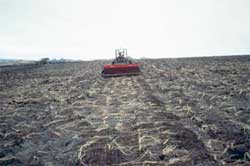Chapter 9: Specialized Equipment Needs
Usually, the contractor supplies the equipment needed to complete a revegetation project. This manual includes a section on equipment in order to inform the project designer of the advantages and drawbacks of each.
Broadcast Seeders
Of all reseeding machinery, hand-operated broadcast seeders are usually the least expensive and
require the least training and support equipment.
Broadcast-type equipment can usually be used for both seed and fertilizer.

Figure 71: Broadcast seeding using shoulder-carried seeders works well on small areas and steep slopes where motorized equipment may have problems.
Drop Spreaders
Drop application methods rely on gravity feed, are simple in design and easy to use. Two problems can occur with this method: stripes can appear if the drop pattern is not overlapped and the equipment will corrode if it is not thoroughly cleaned after applying fertilizer. Stripes can be avoided by setting the spreader at half the recommended application rate and running two tracks perpendicular to each other over the site. Drop spreaders tend to be more precise than broadcast seeders.
Drill Seeders
Drill seeders are used most often in agricultural settings. One brand of drill seeder, the Brillion, has been used for revegetation of mine and construction sites. This seeder has been successful on most soil types, with the exception of very gravelly soils.

Figure 72: Drill seeders are specialized types of equipment that work best on level sites with fine soils.

Figure 73: Brillion seeders are forgiving and can be used on gravelly and rocky sites more reliably than other drill seeders.
Fertilizer cannot be applied with drill seeders. However, the unit incorporates the seed into the soil, packs the seed in place, and provides accurate application rates. The seeding rate can be reduced by 50 percent when a drill seeder is used because of this accuracy.
Hydroseeding
In recent years, hydroseeding has been portrayed as the most effective means for revegetating an area. However, many professionals are finding that this claim is overstated. Hydroseeders are well suited for seeding steep slopes and rocky areas, and they apply mulch, seed, and fertilizer in one step. The primary disadvantage is the requirement for large quantities of water, which can result in numerous trips across the land that is being revegetated. The equipment is complex and mechanical problems can cause delays. Hydroseeder manufacturers have claimed that hydroseeding promotes more vigorous plant growth, but that claim has not proven to be true. In fact, grass growth can be inhibited if too much mulch is applied.

Figure 74: A small tow-behind hydroseeder in use

Figure 75: Hydroseeding a large-cut slope. This is the ideal area and use for a hydroseeder.
Hydroseeders come in truck-mounted and trailer forms. Major contractors either have a hydroseeder or can easily subcontract one. Hydroseeders are also useful as supplemental watering trucks once seed has been applied. Additional watering increases project costs and is not always necessary to produce a good stand of vegetation. Even without additional water application, seed will remain dormant until rainfall provides sufficient moisture for germination.
A hydroseeding contract should state that seed will not remain in the hydroseeder for more than one hour. This will prevent seed from absorbing excess water and being damaged by the dissolved fertilizer.
Table 3: Characteristics of Various Spreading Equipment
|
Type |
Advantages |
Disadvantages |
Hand-held
Spinner Type
Spreaders |
- Inexpensive
- Simple to use & repair
- Can apply both fertilizer & seed
- No special training needed
|
- Slow
- High labor use
- Skip & overlap possible
- Seed may need to be incorporated into the soil following application
|
Mechanical
Spinner Type Spreaders |
- Fast operation
- Can apply both seed & fertilizer
- Relatively low-cost equipment
|
- Skip & overlap possible
- Seed may need to be incorporated into the soil following application
|
Drop Type Spreaders |
- Fast operation
- Simple to use
- Can usually be used to apply both fertilizer & seed
|
- Skip & overlap can be a serious problem if care is not taken
- Difficult to calibrate accurately
- Equipment needs higher degree of care
|
Drill Type Seeders** |
- Seed incorporation not needed as a separate step
- Precise application possible
- Skip usually not a problem
- Uses seed at half the prescribed rate
|
- Does not usually apply fertilizer
- Equipment can be more costly
- Needs higher degree of seedbed preparations
|
Hydroseeders |
- Degree of slope usually not a problem
- Skip not a problem when used with mulch
- Can apply both seed & fertilizer in one application
|
- Equipment costly to own and operate
- Needs water source
- Equipment more complex
|
|